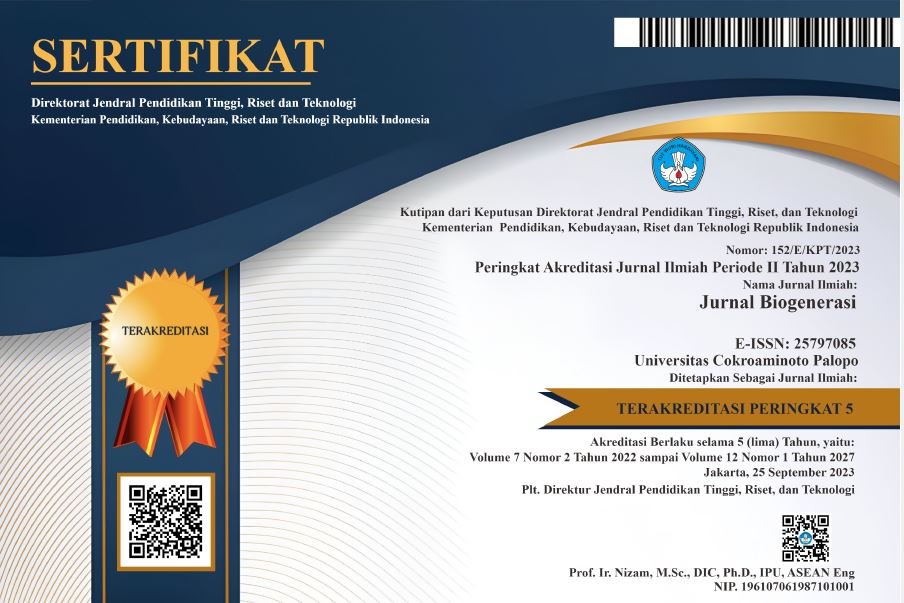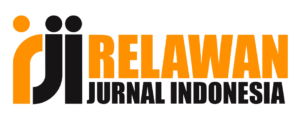IMPLEMENTASI PRINSIP BIOETIKA DALAM PENGUJIAN CEMARAN MIKROBA PATOGEN PANGAN
DOI:
https://doi.org/10.30605/biogenerasi.v10i2.5704Keywords:
Keywords : Food Safety, Pathogenic Microbes, Microbiological Testing, Kata Kunci : Keamanan Pangan, Mikroba Patogen, Pengujian MikrobiologiAbstract
Abstract
Food safety is an important aspect in public health, especially in preventing foodborne diseases. This study aims to analyze pathogenis microbial contamination in several food samples such Dried Anchovy, Dried Shrimp dan Brownies. The test methods used include otal plate count (measuring the total number of microbes in the sample), Most Probable Number (MPN) to detect Escherichia coli, Staphylococcus aureus test and Salmonella test. The results showed that all food samples tested were still within the safe limits set by the Indonesian National Standard (SNI) and the Food and Drug Administration (BPOM) so they were suitable for consumption. Therefore, this study emphasizes the importance of microbiological monitoring and testing in ensuring food safety to prevent health risks due to pathogenic microbial contamination.
Abstrak
Kemanan pangan merupakan aspek penting dalam kesehatan masyarakat terutama dalam mencegah penyakit akibat pangan (Foodborne Diseases). Penelitian ini bertujuan untuk menganalisis cemaran mikroba patogen pada beberapa sampel pangan seperti Dried Anchovy, Dried Shrimp dan Brownies. Metode pengujian yang digunakan meliputi angka lempeng total (mengukur jumlah keseluruhan mikroba dalam sampel), Most Probable Number (MPN) untuk mendeteksi Escherichia coli, uji Staphylococcus aureus dan uji Salmonella. Hasil penelitian menujukkan bahwa seluruh sampel pangan yang diuji masih berada dalam batas aman yang ditetapna oleh Standar Nasional Indonesia (SNI) dan Badan Pengawas Obat dan Makanan (BPOM) sehingga layak untuk dikonsumsi. Oleh karena itu, penelitian ini menegaskan pentingnya pengawasan dan pengujian mikrobiologis dalam memastikan keamanan pangan untuk mencegah risiko kesehatan akibat kontaminasi mikroba patogen.
Downloads
References
Alang, H., Yunus, M., & Hasyim, A. (2022). Analisis Kualitas Telur Asin Di Pasar Pa’baeng-Baeng Berdasarkan Nutrisi Dan Bakteri Pencemar. Bioma : Jurnal Ilmiah Biologi, 11(1), 89–102. https://doi.org/10.26877/bioma.v11i1.9819
Badan Pangan Nasional. (2023). Panduan Penerapan Dan Penilaian Sistem Manajemen Pengawasan Keamanan Pangan Segar Daerah Provinsi dan Kabupaten/Kota. Badan Pangan Nasional.
BPOM. (2019). Peraturan Badan Pengawas Obat Dan Makanan Republik Indonesia. Jakarta: Badan Pengawas Obat dan Makanan.
Badan Standarisasi Nasional (BSN). (2009). Batas Maksimum Cemaran Mikroba Dalam Pangan SNI 7388: 2009.
Badan Standarisasi Nasional (BSN). (2012). Mikrobiologi Bahan Pangan dan Pakan-Metode Horizontal Untuk Deteksi dan Enumerasi Esherichia coli Terduga-Teknik Angka Paling Mungkin (APM) SNI ISO 7251:2012.
Badan Standarisasi Nasional (BSN). (2012). Mikrobiologi Bahan Pangan dan Pakan-Metode Horizontal Untuk Enumerasi Staphylococci Koagulasi Positidf (Staphylococcus aureus dan Spesies Lain)- Bagian 1: Teknik Menggunakan Media Baid Parker Agar SNI ISO 6888-1:2012.
Badan Standarisasi Nasional (BSN). (2012). Mikrobiologi Bahan Pangan dan Pakan-Persyaratn Umum dan Pedoman Untuk Pengujian Mikrobiologi SNI ISO 7218:2012.
Fatimah, S., Hekmah, N., Fathullah, D. M., & Norhasanah, N. (2022). Cemaran Mikrobiologi Pada Makanan, Alat Makan, Air Dan Kesehatan Penjamah Makanan Di Unit Instalasi Gizi Rumah Sakit X Di Banjarmasin. Journal of Nutrition College, 11(4), 322–327. https://doi.org/10.14710/jnc.v11i4.35300
Kurniawan, F. B., Imbiri, M., Alfreda, Y. W., Sahli, I. T., & Hartati, R. (2022). Kualitas Bakteriologi Escherichia coli dan Coliform pada Air di Distrik Demta Kabupaten Jayapura Tahun 2022. Jurnal Analis Laboratorium Medik, 7(2), 66–71.
Meilanda, R., Puspitasari, A., & Kisdaryeti, K. (2023). Uji Aktivtas Antibakteri Ekstrak Biji Alpukat (Persea american Mill.) Terhadap Bakteri Penyebab Diare Escherichia coli dan Bacillus cereus. Jurnal Surya Medika, 9(3), 84–91. https://doi.org/10.33084/jsm.v9i3.6472
Ningsih, D. S., Yaktiworo, I., & Suryani, A. (2018). Keragaman Pedagang Makanan Jajanan Olahan Di Kampus Universitas Lampung. JIIA, 6(2), 205–213.
Rahayu, Y. P., Elysa, D., Mambang, P., Nasution, H. M., & Ramadani, A. (2023). Detection of Staphylococcus aureus Contamination In Local Crispy Chicken Around One Of The Universities Of Medan City Deteksi Cemaran Staphylococcus aureus Pada Ayam Krispy Lokal Di Sekitar Salah Satu Universitas Kota Medan. Journal of Pharmaceutical and Sciences, 6(3), 1356–1362.
Ramadani, A., Rahayu, Y. P., Pandapotan Nasution, M., & Yuniarti, R. (2023). Analysis Of Bacterial Contamination Staphylococcus aureus On Roadside Crispy Chicken Meat And Fast Food In The Teladan Area Of Medan City Analisis Cemaran Bakteri Staphylococcus aureus Pada Daging Ayam Krispy Pinggir Jalan Dan Fast Food Di Daerah Teladan Kota Medan. Journal of Pharmaceutical and Sciences, 6(3), 1265–2.
Ratnaningtyas, S., Wahyudi, D., Wulansari, D., & Utami, W. P. (2023). Deteksi Cemaran Salmonella sp. Pada Komoditas Tuna, Tongkol Dan Cakalang (TTC) Yang Dijual Di Pasar Inpres Di Daerah Istimewa Yogyakarta. Jurnal Klorofil, 7(1), 1-7.
Risdayanti, R., Latif, U. T. A., & Wirawan, H. P. (2023). Deteksi Keberadaan Bakteri Pengkontaminasi Pangan Salmonella sp. Pada Telur. Filogeni: Jurnal Mahasiswa Biologi, 3(3), 117–121. https://doi.org/10.24252/filogeni.v3i3.29811
Safira, N., Rahmayanti, Y., & Auliani, F. D. (2023). Gambaran Cemaran Bakteri Escherichia coli Pada Jajanan di SDN 70 Banda Aceh. Media Kesehatan Masyarakat Indonesia, 22(4), 256–265. https://doi.org/10.14710/mkmi.22.4.256-265
Uliyanti, & Filemon. (2024). Analisis Uji Mpn Bakteri Escherichia coli Pada Sampel Pangan Jajanan Anak Sekolah (PJAS) Di Kota Pontianak. Jurnal Pertanian Dan Pangan, 6(1), 22.
Downloads
Published
How to Cite
Issue
Section
License
In submitting the manuscript to the journal, the authors certify that:
- They are authorized by their co-authors to enter into these arrangements.
- The work described has not been formally published before, except in the form of an abstract or as part of a published lecture, review, thesis, or overlay journal.
- That it is not under consideration for publication elsewhere,
- That its publication has been approved by all the author(s) and by the responsible authorities – tacitly or explicitly – of the institutes where the work has been carried out.
- They secure the right to reproduce any material that has already been published or copyrighted elsewhere.
- They agree to the following license and copyright agreement.
License and Copyright Agreement
Authors who publish with this journal agree to the following terms:
- Authors retain copyright and grant the journal right of first publication with the work simultaneously licensed under Creative Commons Attribution License (CC BY 4.0) that allows others to share the work with an acknowledgment of the work's authorship and initial publication in this journal.
- Authors are able to enter into separate, additional contractual arrangements for the non-exclusive distribution of the journal's published version of the work (e.g., post it to an institutional repository or publish it in a book), with an acknowledgment of its initial publication in this journal.
- Authors are permitted and encouraged to post their work online (e.g., in institutional repositories or on their website) prior to and during the submission process, as it can lead to productive exchanges, as well as earlier and greater citation of published work.


.png)

